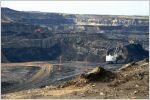
Natural Resources Minister Joe Oliver and Alberta Premier Alison Redford sign a memorandum of understanding in February 2012. Photo: Courtesy Alberta Premier's Office.
Last week, the Harper government outlined its plans to weaken virtually every major piece of federal environmental legislation in Bill C-38, the omnibus budget implementation bill.
Among other things, the changes outlined in the bill would repeal the Canadian Environmental Assessment Act (CEAA) and replace it with a new version of the bill. CEAA 2012 will shift responsibility for many environmental assessments to the provinces (even though some, like Alberta, have been ill equipped to do the job). With this legislation, the federal government is writing itself a substantially reduced role in the business of environmental oversight and protection — and yet ironically, the proposed changes would give the federal cabinet authority to overrule any decision by the National Energy Board that would otherwise reject a proposal on environmental grounds.
Perhaps not surprisingly, given the scope of changes proposed in the budget bill, new polling by Forum Research for the Hill Times indicates that “59 per cent of Canadians believe the federal government has put oil and gas companies’ interests above those of Canadians, while 63 per cent of Canadians do not trust the government to do what’s best for Canada with respect to the environment.”
This has significant implications for Alberta at a time when international scrutiny on the oilsands is magnifying. The proposed weakening of federal environmental laws puts the onus on the province to ensure that its rivers, lakes and groundwater supplies are not being polluted by industrial activity, and that energy development does not compromise the habitat of species at risk, such as the woodland caribou.
In other words, as Ottawa tries to walk away from its responsibilities to manage environmental impacts of industrial activities, it’s increasingly going to fall to Alberta and the other provinces to pick up the slack.
Fortunately, Alberta Premier Alison Redford said last year she intends to be “very bold about what’s going on with respect to our environmental policy in Alberta.” Now that the Premier has a secure majority and a four-year mandate to govern, it’s time for the province to map out what bold environmental policy looks like, and the steps it will take to get there.
19 “bold” steps toward environmental responsibility
A lot of research has already gone into developing a road map to environmentally responsible oilsands development, so identifying the policy solutions is the easy part.
This time last year, the Pembina Institute released a report called Solving the Puzzle, which outlined 19 policy steps the Alberta government could make to improve environmental management in the oilsands specific to five key areas: land, water, air, greenhouse gas emissions, and monitoring. Although the recommendations in the report are rigorous, change is necessary to rebuild Canada’s reputation and enable Alberta’s energy industry to regain its social license to operate.
Advancing Alberta’s climate policies
 Key climate policies outlined in our Solving the Puzzle report discuss how Alberta needs to commit to a provincial greenhouse-gas reduction target that is consistent with the province’s fair share of national emissions reductions. Alberta must also expand its carbon price to cover the vast majority of provincial greenhouse gas pollution (rather than just the fraction of emissions covered under the province’s current carbon price), and increase that price to a level that would drive emissions reductions (since the current penalty for producing emissions isn’t high enough to spark a change in behaviour).
Key climate policies outlined in our Solving the Puzzle report discuss how Alberta needs to commit to a provincial greenhouse-gas reduction target that is consistent with the province’s fair share of national emissions reductions. Alberta must also expand its carbon price to cover the vast majority of provincial greenhouse gas pollution (rather than just the fraction of emissions covered under the province’s current carbon price), and increase that price to a level that would drive emissions reductions (since the current penalty for producing emissions isn’t high enough to spark a change in behaviour).
Further, the province should require the use of carbon-capture and storage (CCS) technology to trap emissions from all major new industrial sources. CCS was the central plank of Alberta’s climate change plan, but the province’s much touted commitment to subsidize CCS is now on shaky ground after TransAlta’s high-profile decision to abandon its CCS project, citing the lack of market incentives to drive the project.
As long as greenhouse gas emissions from oilsands production continue rising sharply (particularly at a time when most other industries in Canada and other major industrialized economies are cutting emissions to prevent dangerous climate change), Alberta will continue to face pressure from inside and outside its borders to get greenhouse gas pollution under control.
Protecting Alberta’s air, land and water quality
The rest of our policy recommendations are focused on protecting air, land and water — and the species and people who depend on these things — from the cumulative effects of industrial development. The list of steps the province needs to take to ensure responsible energy development includes committing to:
- increase its protection of public forests and require three times as much land to be conserved or restored as is disturbed in the Boreal region;
- collect enough financial security from companies to cover the total liabilities associated with oilsands extraction;
- set a maximum limit on oilsands development in caribou habitat;
- establish a water management plan for the lower Athabasca River to ensure that water withdrawals stop when river flow reaches critically low levels;
- measure groundwater resources and set legal requirements to ensure groundwater use is sustainable;
- ensure regulations protecting non-saline groundwater resources are up-to-date and enforceable;
- establish air emission limits that meet the World Health Organization’s standards for air quality and human health and require oilsands operations to use the best-available technology to reduce air emissions; and,
- only approve new oilsands mines that use proven technology to eliminate wet tailings, and require all current mines to conform to new tailings rules.
Restoring Alberta’s reputation (no help from Ottawa)
A major challenge for Alberta going forward will be convincing its critics that it means to walk the talk when it comes to being an environmentally responsible energy producer. Ottawa has made this more difficult by abandoning any pretence of balancing environmental protection with economic development, upping the ante for Alberta to fill the gaps left behind.
Implementing the full suite of policies recommended in Solving the Puzzle would enable Premier Redford to deliver on her commitment to “bold” environmental policy, demonstrating to the world that Alberta takes its role as the province’s environmental manager seriously.
Jennifer Grant was the Pembina Institute's associate regional director for Alberta and the North until 2013, and former director of the Institute's oilsands program.



